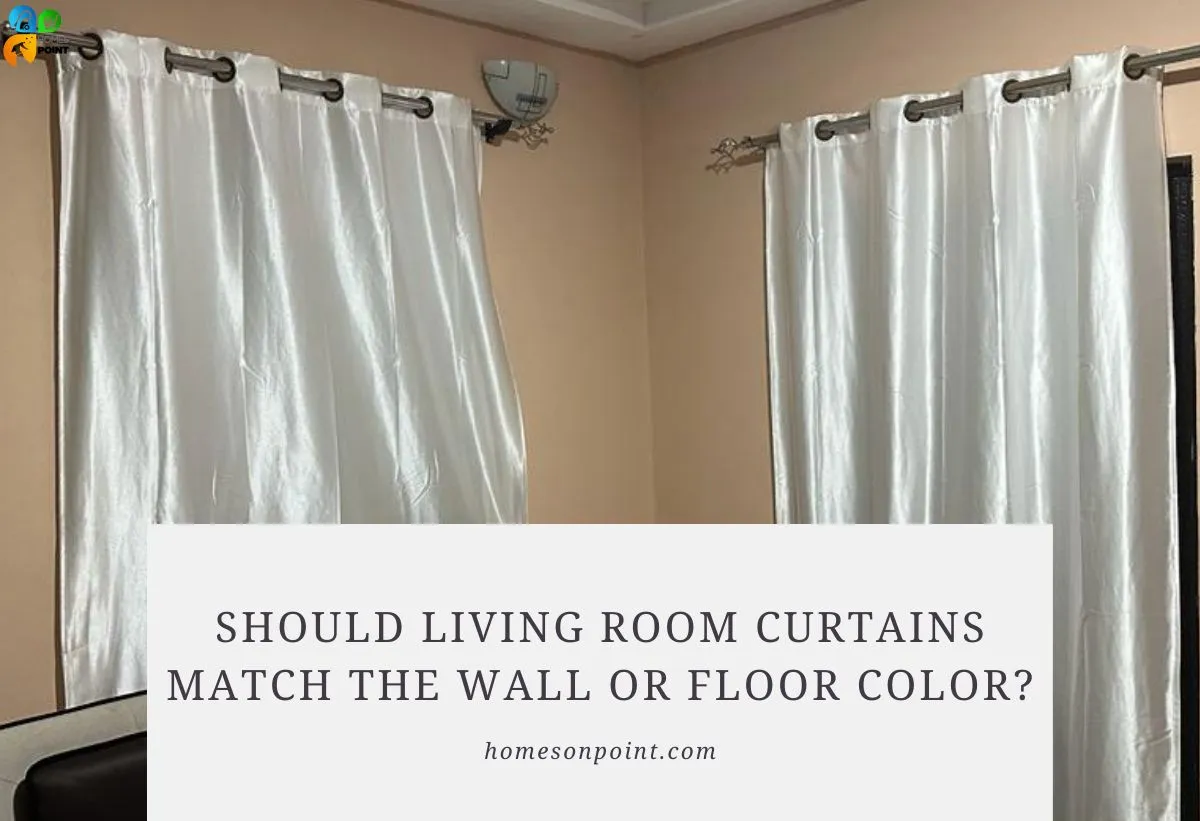For someone who puts a lot of thought into how their space should look, it is no surprise that you would deliberate on whether your living room curtains should match the wall or floor. Considering that the living room is primarily one of the first rooms any guest enters a house, it is natural that you would want to get things right in there.
Curtains do play a vital role in the general aesthetic of any room. Honestly, no strict guidelines impress upon you to match your living room curtains with your walls or floor. However, a few guiding principles can help give your living room a cohesive look when coupled with your personal preference and style.
Understanding The Role Of Living Room Curtains
Benefits Of Curtains
1. Privacy
If your windows or doors do not have any curtains hanging on them, there is an excellent chance that passers-by can see into your house. By this, I mean without curtains, you may not have the level of privacy you desire in your home. Without privacy, your security may also not be guaranteed, and I’m sure you do not want that.
Privacy also translates into the lighting you allow into your house with curtains. Indeed, curtains also help to control natural lighting in any space. Open and close your curtains to increase or decrease the light reaching your space.
2. Thermal Regulation
Curtains can help regulate the temperature in your room. During the warm seasons, you can open your curtains to allow fresh air and sunlight into your room. Also, keeping your curtains close during cold seasons can help the room stay warmer.
3. Sound Absorption
If any room in your house sounds echoey, try hanging up curtains in that room, as that can help absorb the “extra” sound. Generally, fabrics in a room absorb sound, and curtains, especially when thick, can absorb sound and reduce echoes.
4. Decorative Element
It cannot be overemphasized that curtains add an aesthetic touch to any room. With the right color, texture, and pattern, curtains can improve the overall visual look of a room. The right curtains can transform an ordinary-looking space into an extraordinary one.
Matching Curtains With Walls
Benefits Of Matching Curtains With Walls
1. Cohesive Look
Matching your curtains with your walls results in a cohesive, unified look. If you match your curtains with your walls, your room looks more put together. For instance, if you have white walls, you can have curtains that match the walls.
The curtains do not have to be white or have a touch of white, which I will explain later. Aesthetically, it makes more visual sense when elements in a room match, including matching the curtains with the walls.
2. Illusion Of Space
Another benefit of matching curtains with walls is that it makes the room look bigger than it is. If you think your room is small, a trick will be to match your curtains with your walls, as that opens up the space. Of course, this does not mean literally but creating an illusion of more space. This further allows other decorative elements of the room to be more prominent.
3. Enhancing Color Scheme
Matching your curtains with your walls enhances the color scheme of the room. This has nothing to do with using the exact shade of colors for both curtains and walls. However, if much thought goes into matching your curtains with your walls, it highlights the entire room’s color scheme and theme.
Considerations When Matching Curtains With The Wall
As previously stated, matching your curtains with the walls does not necessarily mean having both in the same colors. There are three possibilities for matching your curtains with your walls.
1. Different Shades and Tones Of The Same Color
If you pick grey, for instance, you can have a lighter shade for your walls and a darker shade for your curtains. If done right, different shades and tones of the same color will work perfectly when matching your curtains with your wall. You can even play around with three or more shades and tones of the same color.
2. Complementary or Contrasting Colors
This is where the color wheel comes in handy, as it gives you an idea of which colors complement and contrast. For instance, if you want to use complementary colors when matching your curtains with your walls, you can do light blue walls with burnt orange curtains. An example of contrasting tones will be yellow walls against purple curtains.
3. Textures and patterns for added visual interest
Aside from colors, textures and patterns should also be considered when matching your curtains with your walls. Are you going for lighter, flowy curtains or thicker ones? Would you instead do floral patterns or geometric ones? Are your walls textured or smooth? Varying textures and patterns can help you look flawless when matching your curtains and walls.
Matching Curtains With The Floor
Most people do not pay much attention to matching curtains with the floor of a room. However, it can be worth your while, and these are the reasons why.
Advantages Of Matching Curtains With The Floor
1. Sense Of Continuity
Though the floor may not necessarily be the first focal point in a room, matching it with your curtains can create a flow. It is sometimes visually appealing to create continuity with your interior decoration and design, so matching curtains with the floor is one way to achieve that.
2. Creating A Balanced Look
Matching your curtains with the floor creates a balanced look in the space. Some colors seem a bit heavier than others, so it helps to mix and match them so the room is not slop-sided. For instance, if you decide to go with nude floor tiles, it will help you balance it with bright-colored curtains.
3. Making The Flooring A Focal Point
Since the floor is naturally not a focal point in a room unless it is empty, matching your curtains with the floor draws attention to your flooring. You could have this great pattern with your flooring and would love for people to notice it when they walk into your space. Try matching your curtains with the floor to make that your focal point.
Factors To Consider When Matching Curtains With The Floor
1. Flooring Material And Color
The color and material of your flooring matter when matching it with your curtains. Wooden flooring will have different considerations than tile flooring as those are other materials and colors. Wooden floors present a more structured look and would be great when paired with flowy light curtains to balance the look.
2. Existing Furniture And Décor Elements
You may miss the point if you focus only on the floor and curtains when matching them. You must consider existing furniture and décor elements in the space if you already have these or are sure about which ones you are buying. As part of creating a cohesive look when matching curtains with the floor, the other elements in the room also matter.
Practical Considerations When Deciding On Colors For Your Living Room Curtains
3. Budget Constraints
The primary deciding factor for most people when buying living room curtains is how much they cost. A wide range of living room curtains come at different prices because of differences in fabric and quality.
In deciding on colors for living room curtains, have your budget in mind because some rare colors may be more costly than commonly found ones.
4. Existing Furniture And Décor
Though rarely considered, one of the factors that should influence your choice of color for your living room curtains is existing furniture and décor. This point is with the assumption that you already have in mind what furniture you’re getting for your living room or already have it. Considering these before choosing your curtain color will help maintain cohesion and balance in your living room.
5. Personal Preferences And Style
It cannot be overemphasized that what may draw you to a particular living room curtain color is if you like it. If your favorite color is yellow, you may be tempted to curtains that have yellow undertones.
Again, these colors evoke certain styles and themes, so if you are drawn to the color, you most likely prefer the style it exudes. For example, if I pick purple curtains, I may intend to radiate royalty in my living room.
Consequently, it helps to see a lot of colors physically, make as many choices as the above factors will allow, and deliberate on which color living room curtains work for you. Of course, one or more of the factors may weigh more heavily on your final decision than others, which is okay.
Alternatives and Combinations In Choosing Curtain Colors For Your Living Room
When choosing colors for living room curtains, the possibilities are endless. Though it ultimately comes down to your preference and style, other considerations may narrow your decision and make it easier.
One scenario is to choose curtains that have contrasting or complementary colors. The color wheel can help if you pick the curtains out without professional help. Colors that are side by side to each other on the wheel complement each and the most contrasting colors are those opposite each other. With these colors, you can get as bold or subtle as you want.
If you want to play it safe, neutral-colored curtains can also work in your living room. Neutral tones like white, black, grey, and nude can add a touch of simplicity and elegance to your living room. Those colors make the living room look easy and make it much easier to match other elements in the room.
For the free-spirited among us, you can dare to mix and match colors and patterns. If it appeals to you and looks good, do not be afraid to experiment with different colors and patterns. It will help to visit showrooms and place these colors and patterns beside each other to know if they work well together before purchasing.
Conclusion
Choosing curtains can be a big deal, and if you have an eye for good things, you would want to match your curtains with other elements in the space. There are no hard and fast rules to matching curtains with either walls or floors in the living room.
You certainly will have a preference for which colors, patterns, and materials you want, which should ultimately be a significant deciding factor. Other considerations like your budget, other elements in the living, and your decision to mix and match different colors, textures, and patterns will also indirectly affect your final choice.

